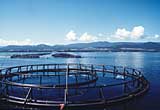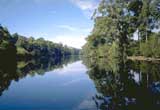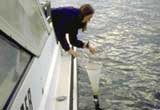Summary of The
Study
On this page...
Understanding the Huon Estuary
The Huon River and its estuary in southeastern Tasmania have
supported the mature enterprises of forestry and horticulture
since early in the region's settlement. The Huon valley community
is now developing a more broad-based economy with the new industries
of tourism and aquaculture. Comprehensive and effective management
of the catchment and waterways are fundamental to a prosperous
future that is in harmony with the natural ecosystem. The Huon
Estuary Study has been a three-year research program to improve
knowledge and provide a scientific framework for such management
of the estuarine zone of the Huon River.
 Our
project was founded on the need to evaluate the environmental
quality and understand the working of the estuary as a system.
Although the farming of finfish in these waters provided the
impetus for the research, the industry was studied in the context
of the entire estuary, and beyond to the catchment where appropriate.
Increasingly, it is recognised that estuaries and other coastal
water bodies are managed well when governed on a catchment scale.
To contend with this complexity, the study took an interdisciplinary
approach that combined expertise in physics, chemistry and biology,
and considered the important time and space scales. Our
project was founded on the need to evaluate the environmental
quality and understand the working of the estuary as a system.
Although the farming of finfish in these waters provided the
impetus for the research, the industry was studied in the context
of the entire estuary, and beyond to the catchment where appropriate.
Increasingly, it is recognised that estuaries and other coastal
water bodies are managed well when governed on a catchment scale.
To contend with this complexity, the study took an interdisciplinary
approach that combined expertise in physics, chemistry and biology,
and considered the important time and space scales.
[top]
Goals of the study
-
Determine the sources, distribution and cycling of nutrients
(including those from finfish farming) in the Huon River
estuary, and relate nutrients and physical parameters to
algal dynamics.
-
Evaluate the processes (and their rates) that contribute
organic matter to sediments from finfish farming and natural
sources; and the significance of this organic matter in the
cycling of nutrients through the sediments.
-
Determine the sedimentary distribution of organic matter
around the fish cages that ensues from salmonid farm operation,
and the time needed for degraded sediments to return to ambient
conditions when cages are removed (the latter is a pilot
experiment only).
- Test the usefulness of different methods for monitoring
the environmental quality of sediments and the water column
to, (i) provide a scientific basis for the design of a monitoring
framework for both industry and environmental managers, and
(ii) give technical advice on optimising such a framework
to address both localised impacts and general estuarine conditions.
[top]
The estuary
 The
Huon Estuary is a strongly stratified waterway; the Huon River
flows consistently throughout the year and drives a two-layer
estuarine circulation, with a shallow, fresher layer flowing
seaward over a deeper, marine bottom layer moving sluggishly
upstream. Other features include: fast flushing times (the surface
layer swept out in hours to days, and the whole water column
in days up to one week), and low turbidity (but light penetration
is diminished by high levels of coloured dissolved organic matter). The
Huon Estuary is a strongly stratified waterway; the Huon River
flows consistently throughout the year and drives a two-layer
estuarine circulation, with a shallow, fresher layer flowing
seaward over a deeper, marine bottom layer moving sluggishly
upstream. Other features include: fast flushing times (the surface
layer swept out in hours to days, and the whole water column
in days up to one week), and low turbidity (but light penetration
is diminished by high levels of coloured dissolved organic matter).
Autonomous profiling systems deployed at two sites in the lower
estuary showed rapid fluctuations in physical properties caused
by run-off and wind mixing. Currents are generally weak (< 0.2
m s-1), and tidal currents even weaker in this microtidal system.
The Huon and its neighbouring estuary, the Derwent, share many
physical features in common and presumably function similarly;
knowledge from one can be applied to the other.
[top]
Water quality
We find that the Huon Estuary is a 'substantially natural' waterway
that has not changed dramatically from its historic baseline.
In general, its environmental quality is high and that of its
two main source waters
— the Huon River and coastal waters of southeast Tasmania —
is very high. We flag three issues for further attention by managers.
-
The first is the degraded quality of some lower catchment
streams, apparently as a result of land-based activities
in their subcatchment. Up to now, the effects of their deterioration
remains localised.
-
The second is dissolved oxygen. Oxygen depletion in deeper
holes in the upper estuary may have natural causes, but we
also observed a few instances of very low concentrations
in bottom waters in the lower estuary in summer.
- The final issue of concern is the appearance of raised
levels of ammonia and nitrite (readily available forms
of nitrogen for microalgae) in bottom waters in the lower
estuary after dense microalgal blooms. In combination with
oxygen depletion, these increased nutrient concentrations
indicate that sediments are recycling and releasing nutrients
efficiently back to the water column, making the estuary
more vulnerable to increases in nutrient loads.
[top]
Estuarine sediments
 The
sediments of the estuary are mostly muds, with small regions
of sand near the mouth and in the upper reaches above Crowthers
Bay. The muds have high organic matter content. Much of this
is historical: from land plants in the upper estuary, and from
phytoplankton production in the middle and lower estuaries. This
high proportion of organic matter contributes to the vulnerability
of the bottom waters to oxygen depletion. Hospital Bay (Port
Huon) sediments are different, apparently because of past sawmill
and pulp mill operations on the shores of this water body. The
sediments of the estuary are mostly muds, with small regions
of sand near the mouth and in the upper reaches above Crowthers
Bay. The muds have high organic matter content. Much of this
is historical: from land plants in the upper estuary, and from
phytoplankton production in the middle and lower estuaries. This
high proportion of organic matter contributes to the vulnerability
of the bottom waters to oxygen depletion. Hospital Bay (Port
Huon) sediments are different, apparently because of past sawmill
and pulp mill operations on the shores of this water body.
A preliminary survey of contaminants (trace metals and pesticides)
— in sediments and water of the estuary — revealed
no levels above national guidelines, apart from higher concentrations
of the organochlorine pesticides DDT and DDD in a sediment sample
from Hospital Bay. However, a follow-up survey with more sensitive
measurements of pesticides currently used in the catchment would
be advisable.
[top]
Algal blooms
In the Huon Estuary, we observed a close link between physical
conditions (e.g. light, temperature, salinity layering) and populations
of microalgae. Blooms of diatoms and dinoflagellates alternate
from spring to autumn in most years. During both years of our
field program (1996/97 and 1997/98), diatom blooms were observed
in spring and late summer, but their biomass was quite low (1—2
mg chlorophyll a m-3). Dinoflagellate blooms were not observed
in the first year, but dense blooms (typically 20 mg chlorophyll
a m-3) of the toxin-producing Gymnodinium catenatum developed
early in the summer and autumn of 1997/98, along with less intense
blooms of other dinoflagellates.
Nitrogen seems to be the limiting nutrient for microalgal production
in estuary waters. Surface-water depletion of nitrogen is not
such a constraint for dinoflagellates, because these microalgae
can migrate vertically to draw on nutrients in bottom waters
and return back up to the light for photosynthesis. By moving
between outflowing surface waters and inflowing bottom waters,
dinoflagellates also appear to avoid being flushed out of the
estuary, and are able to accumulate high biomass levels.
We have identified the environmental conditions that support
blooms of G. catenatum (largely corroborating earlier research),
but still elusive are the factors that prevent blooms forming
in apparently suitable years (e.g. 1996/97). Resting cysts of
the dinoflagellate in sediments, and their mechanism of germination,
could hold the key.
[top]
Nutrient cycling
 Key
environmental issues in the Huon Estuary are associated with
the effects and fate of nutrient and organic matter loads from
the catchment, from coastal waters, and from activities in the
estuary, especially salmon farming. We combined field observations,
budgets, and simple process models to understand nutrient cycling
in the estuary. These general conclusions were reached for the
critical nutrient nitrogen. Key
environmental issues in the Huon Estuary are associated with
the effects and fate of nutrient and organic matter loads from
the catchment, from coastal waters, and from activities in the
estuary, especially salmon farming. We combined field observations,
budgets, and simple process models to understand nutrient cycling
in the estuary. These general conclusions were reached for the
critical nutrient nitrogen.
-
About half the available nitrogen (for biological production)
entering the estuary, under existing conditions, comes from
bottom waters at the marine boundary. The other half is split
almost evenly between agricultural run-off and from operation
of salmon farms. (Large fluxes of marine nitrate circulate
through the estuary in winter, but this is largely unutilised
due to low light.)
-
The Huon River discharges appreciable quantities of total
nitrogen from the upper catchment, but it is mostly refractory
organic nitrogen; the upper catchment is a negligible source
of available nitrogen.
- Overall, the estuary is a substantial sink for total nitrogen,
which must be either buried in sediments, or lost to the
atmosphere (as gaseous nitrogen through denitrification).
The balance between the two remains to be elucidated.
[top]
Finfish farming
We looked at a number of aspects of finfish farming. At the
scale of the lease site and its operation, our focus was on the
fallowing of the sediments beneath sea-cages. A pilot study of
fallowing of single cage sites in an operational farm revealed
that most of the waste deposited directly beneath the cage, and
in declining amounts moving away from it. After an 11-month interval
without a cage overhead, the anoxic conditions in surface sediments
had returned to oxic. Nevertheless, a significant part of the
organic waste still remained. Further work is needed to find
out whether this incomplete breakdown of organic matter has implications
for site re-occupation.
Salmon farms may affect water quality nearby their sites. Our
field observations yielded evidence of higher ammonia concentrations
in surface and mid-depth waters close to the marine farm zones.
However, phytoplankton levels were not significantly elevated
at sites near fish farms: we conclude that nutrients disperse
before phytoplankton can respond. Sporadic observations were
also made of oxygen-depleted bottom waters near marine farms.
[top]
The effects of expansion
The effects of nutrient loads from salmon farms must be considered
at estuary-wide scales. We used a simple algal bloom model to
look at effects of increasing salmon farm loads to twice, four
times and ten times present-day values. According to the model,
doubling fish farms from present levels in the waterway will
increase biologically available nitrogen by 50%. At four times
the current loads, available nitrogen is doubled again, and the
predicted phytoplankton biomass (measured as chlorophyll a) is
about twice current levels. In this circumstance, nitrogen is
scarcely limiting and a substantial risk of prolonged algal blooms
would arise. At ten times the existing loads, there will be sufficient
available nitrogen to saturate phytoplankton growth; the ecosystem
will become eutrophic.
From experience gained in our observational program, we have
proposed an automated, catchment-scale monitoring network which
should meet the broad requirements of the region. Marine farmers
will be able to gain operational data from autonomous instrument
systems strategically located in the estuary, and backed up by
simpler devices about their farms. Regional environmental managers
will be able to draw on the integrated network of estuarine instruments
and sensors in the catchment and on tributary streams to monitor
the effects of change, and also to derive product for environmental
forecasting and scenario testing.
[top]
Environmental issues
As a result of our research, we have identified a number of
issues that merit further attention by environmental custodians
of the Huon Estuary. It is strongly recommended that they be
read in their context in Chapter 11 of the report. We advise
that:
-
the current, near-pristine state of the upper Huon catchment
should be carefully maintained because it is the main source
of freshwater to the estuary, and thorough measures are instituted
to prevent localised degradation from human activities;
-
management plans designed to prevent further deterioration
of the lower subcatchments should be implemented, and steps
taken to improve the quality of run-off from the degraded
subcatchments;
-
information pertaining to nutrient budget estimates in the
Huon Estuary is kept up to date, and is made as comprehensive
as possible (this could form part of a broader catchment
audit process);
-
any development planned for Hospital Bay (or nearby in the
main estuary) that could disturb the underlying sediments
should require a survey of the sediment quality and characteristics;
-
a formal risk assessment of the system's carrying capacity
should be carried out to underpin any further expansion of
finfish farming in the Huon Estuary;
-
the salmonid-farming industry work with government and research
agencies to establish a more detailed understanding of the
environmental effects of different fallowing practices with
the objective of developing generic guidelines;
-
near-field effects of marine farming on water quality should
be reconsidered, to ensure that regulations and compliance
measures are appropriate;
-
all users and other stakeholders of the Huon Estuary work
in concert to develop a monitoring strategy, and foster the
design of monitoring systems, to assist with informed decision-making
about the use of the estuary and developments along its shores;
-
any monitoring program seeking to identify causative factors
for harmful algal blooms include measurements of parameters,
at weekly intervals, (or even daily at critical periods),
that are indicators of environmental conditions known to
support bloom events, along with integrated phytoplankton
analysis; and
-
given the importance of the Huon Estuary as a site for salmonid
culture, and its potential role as a model system both nationally
and internationally, we suggest that the development of an
integrated decision-support system for the Huon Estuary should
be considered.
A set of recommendations on research gaps is also presented
in the final chapter of the report.
[top]
Updated:
12/11/08

|
|